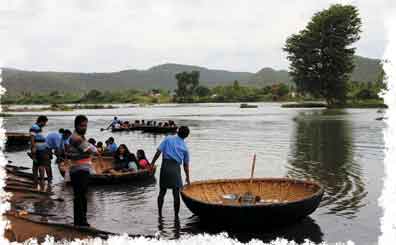Zeba Raziunnisa
The word ‘Sustainability’ is often associated with environment. But as an idea it is much more. Often explained as the capacity to endure, it can be applied to education, relationships, businesses, health, tourism and art as well as to dimensions like energy, development, and architecture. For a process to be sustainable it would have to be interest driven, innovative and efficient, ensuring that the quality does not degrade. This issue of Teacher Plus examines sustainability within the realm of environment. While we have tried to include articles on several issues that need to be addressed, there are still many more that could not find a place due to space constraints. We present a few of them here.
 Eco-tourism
Eco-tourism
Eco-tourism is responsible travel to natural areas that conserve the environment and improve the well-being of the local people. A tourist destination to a far away land cannot be called eco-tourism unless it benefits and helps conserve and improve that environment and raise awareness and funds to help protect it. Eco-tourism is an innovative approach to maximize the economic, environmental and social benefits of tourism.
Ecotourism is geared towards uniting conservation, communities and sustainable travel, building environmental and cultural awareness and respect, providing positive experiences for both visitors and hosts, providing financial benefits for conservation and for the empowerment of the local people. Eco-tourism aims at preserving and sustaining the diversity of the world’s natural and cultural environments. Its approach to tourism is minimally intrusive or destructive to the environment and sustains and supports the native cultures in the locations it is operating in.
Consumption
Population control and meaningful consumption are two important aspects of environmental sustainability. Environmental campaigners stress that the world has a seriously lopsided consumption pattern, where a huge majority of humans use very little of the Earth’s resources, while a small minority use the vast majority of natural wealth. The World Bank estimates that the richest fifth of the world has more than three-quarters of the income; while the poorest fifth has just 1.5 per cent.
Problems of overconsumption, exploitation, uneven distribution of resources, pollution and reckless use of raw materials hold great consequence for each one of us. Recent consumption trends have sparked overwhelming levels of environmental deterioration. If allowed to continue unchecked, the dismantling of the natural world can have catastrophic effects. Small steps like careful and wise use of resources, minimization of waste and pollution and use of renewable resources are easy achievable goals. Lifestyle changes and meaningful consumption are key to environmental sustainability.
 Population
Population
The world population reached 7 billion on October 31, 2011. With an average of 4.17 births per second the United Nations has projected the world population to touch 9.3 billion by 2050, and India is expected to overtake China to be the world’s most populous country by 2025.
The rising numbers would not be a growing concern if there were enough resources to go around. However, population has to be balanced against depleting resources, safeguarding the environment and protecting against climate change.
Population sustainability is an important part of sustainable development, the logic being – as the pie cannot be enlarged, reduce the number of hands competing for a share. World Population Day observed on July 11 every year is an annual event established to raise awareness of global population issues.
 Birds as environmental indicators
Birds as environmental indicators
Environmental indicators are a subset of sustainable development indicators. Environmental indicators help trace and understand changes taking place in the ecosystem.
One of the most effective and significant indicators of environmental health are birds, as they score highly on many of the criteria defined for selecting environmental indicators. Researchers study birds to compare their diets from different locations to see how the local environments affect nutritional intake and the overall health of bird populations. Even a feather from each bird, can help explain the environments in which they live and, likewise, the overall health of the environments in which we all live.
Changes in bird populations tend to integrate a set of ecological factors and can provide a useful indication of environmental change. Migratory birds are valuable and key indicators of environmental health. A shift in migratory patterns reflects a serious environmental change. If the birds have trouble migrating and surviving, it is a sign that the environment is also in trouble.
 Green Architecture
Green Architecture
An interesting and sensible way to be a part of the green movement is to adopt Green Architecture. Green architecture refers to the creation or restructuring of buildings that is environmentally responsible and resource-efficient, right from the building’s design and construction to its long-term operation and maintenance.
Green architecture is designed to reduce the overall impact of a structure through an efficient use of energy, water and other resources, improving indoor environment quality, protecting occupant health, and reducing building operating cost and waste through use of eco-friendly building materials and construction practices.
A basic green design would include the strategic placement of windows to decrease the demand for artificial light during the daytime, ventilation systems for efficient heating and cooling, collection vats to harvest rainwater, using organic building material wherever possible, taking advantage of renewable resources like solar energy and wind energy, use of recycled architectural salvage and an efficient use of space to effect a minimal loss to the natural habitat.
 Ecological Footprint
Ecological Footprint
Ecological Footprint is an effective resource accounting tool that measures humanity’s demand on nature. It measures how much land and water area a human population requires to produce the resource it consumes and to absorb and mitigate associated waste.
Conceived in 1990 by Mathis Wackernagel and William Rees at the University of British Columbia, Ecological Footprint accounts provide a robust estimate of human demand on the biosphere as compared to the biosphere’s productive capacity. Ecological Footprint records have shown that since the 1970s, humanity has been in an ecological overshoot with the annual demand on resources exceeding what the Earth can regenerate each year. Such an overshoot is ecologically unsustainable and highlights the reality of ecological scarcity.
Ecological Footprint of a population can assess our pressure on the planet, which helps us manage our ecological assets more wisely and take personal and collective action in support of a world where humanity lives within the Earth’s bounds.
The author is a freelancer based in Hyderabad. She can be reached at zeba_117@yahoo.co.in.
